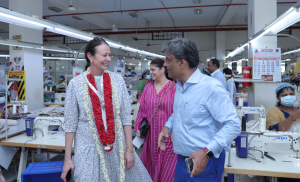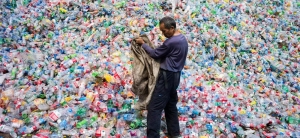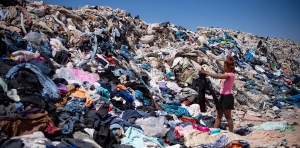Could Seawater Dyeing be the Future of Fashion?
Could Seawater Dyeing be the Future of Fashion?
Thirsty Business
The fast fashion industry is often criticised for the large quantities of water it uses, pollutes and wastes. The water used to dye the clothes we wear is generally taken from rivers, streams and reservoirs local to the manufacturing units, meaning that surrounding communities must share their precious freshwater supplies with an industry that can use over 9 trillion gallons of water annually.
Not only must water used for the actual colouring of cloth, but it is also used for the treating, cleaning, cooling and rinsing of fabrics and equipment.
The huge quantity of water consumed by the dye industry is often heavily polluted with toxic chemicals and the effluents flow untreated back to the water sources from where they originated. Pure Earth (formally Blacksmith Institute) is an organisation with the goal of identifying and remediating polluting toxins in low and middle income nations. It cites the dye industry over 50 times on its database and states that current dye industry practice is putting more than a million people at risk.
Scare Supplies
According to the U.S geological survey less than 3% of Earth’s water is freshwater, and over 68% of that is trapped in the icecaps (for now). This means that of all the water on earth only 0.96% of it is fresh, accessible and suitable for human consumption.
How can it be that whilst so many of us in the world do not have access to freshwater, every year the dye industry uses 9 trillion gallons of water? This quantity roughly translates as enough water to sustain 1 billion households of 4 people for 112 years.
Solving the Problem
It is unrealistic to suggest a boycott of the dye industry for a number of reasons. One being that we have dyed our clothing for thousands of years and adorning oneself in colourful cloth has become a societal part of being human. Another is that the practice employs many people across its supply chains worldwide, and to dismantle would result in widespread unemployment and loss of income for households.
What if we began to dye cloth using the vast quantities of seawater? How would that affect colourfastness? And how feasible a solution is it to the problems caused by conventional textile dyeing?
Researchers in Dhaka, Bangladesh have attempted to answer these questions by carrying out extensive sampling using chemical dyes, cotton and seawater and compared them to control variable samples dyed using groundwater. The samples were compared across a wide range of areas such as shade difference, colourfastness and colour strength and found that although the seawater fabrics were slightly lighter in shade compared to the freshwater fabrics, they displayed satisfying results over all of the other parameters.
This research presents the interesting possibility of sea water fabric dyeing being carried out on a broader scale.
Clearly adopting this idea on a mass scale would open up a different set of issues and debates surrounding dyeing such as the location and methods of the seawater extraction. What laws and regulations would we have to put in place to prevent chemical dye pollution, the disruption of marine ecosystems and over-extraction in a single area?




